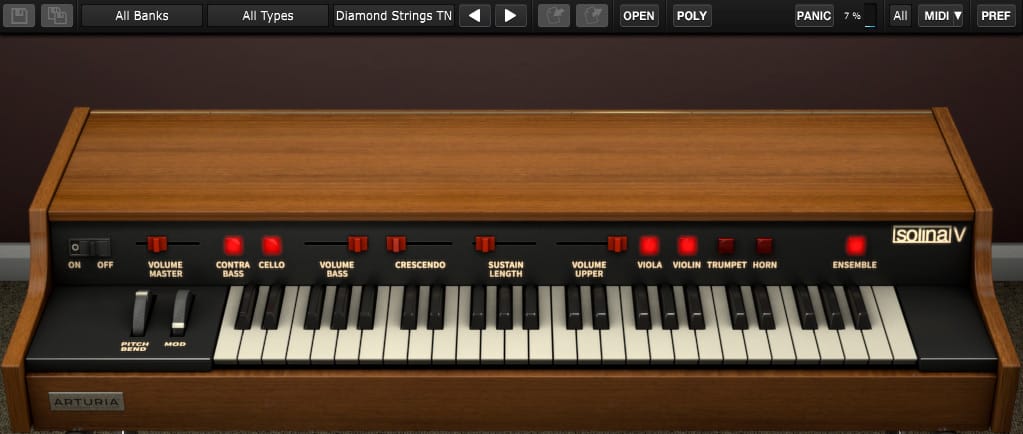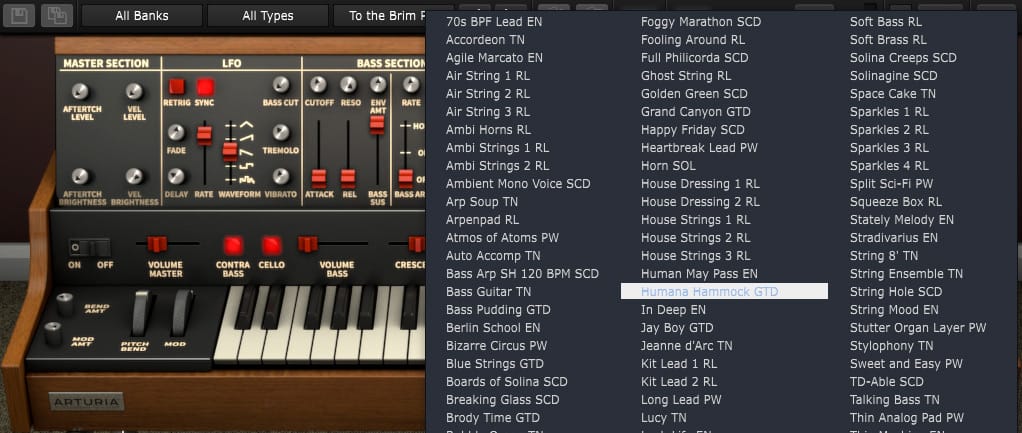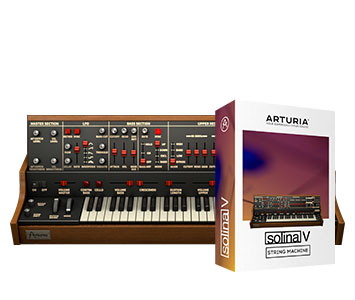The Solina V is our latest venture into classic keyboards. We have modeled and faithfully reproduced the classic Arp/Eminent Solina string ensemble to generate those warm and fuzzy string sounds that graced so many hit records.
The Solina Story

The Solina was best known as a product that was sold by the Arp company in the mid to late 70’s. However the Solina actually originated from the Eminent Organ company in the Netherlands.

It began it’s life as a part of the Eminent 301 organ but due to the response, they decided to separate the string machine part and make the standalone Solina in 1974.
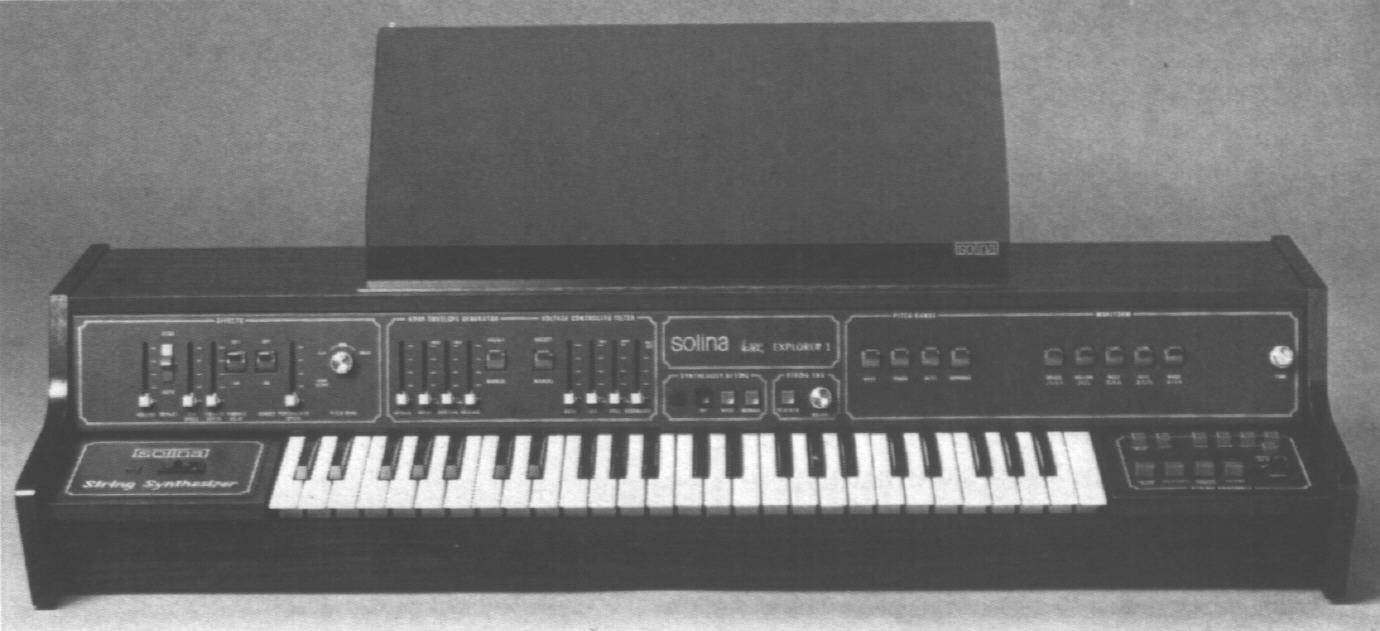
Arp had been looking to make a string machine but then cut a deal to license and sell the Solina as an Arp product. The Arp and Eminent versions of the Solina were exactly the same all the way through; just different silkscreen.
We used the schematics from the Arp Solina and then did careful audio analysis and measurements alongside a vintage Eminent organ to make sure that the final models had the same sound and character of the original.
Strings and Things
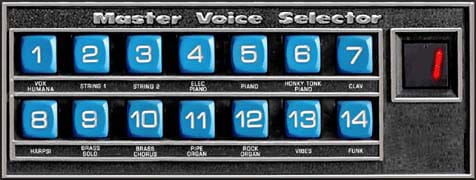
When we started making the Solina we wanted to bring some other unique features to it that would enhance the sound and expand on the possibilities. One of the greatest ‘top-octave’ instrument sounds is the famous Vox Humana from the Polymoog™ synth that was made by Norlin in the late 70’s. This sound graced many albums but was best known for its use on Gary Numan’s early albums.
This same product had a unique filter bank that had 3 filters in parallel and offered 3 modes for the filters. We added this control in our OPEN mode that exposes many new features.
Also in the OPEN mode are the controls over the bass section. We added an arpeggiator and a ladder style filter to open up new possibilities of sound creation.
SSAt one point in the life of the original Solina they changed the ENSEMBLE effect and made it stereo in the MK2 model. We have included both the original mono ensemble as well as the stereo version. This is a huge part of the Solina sound and something that you will not find in sampled versions of the Solina. No others recreate this effect based on the original designs. Most just give you a generic chorus effect and try to sell it as the real deal.
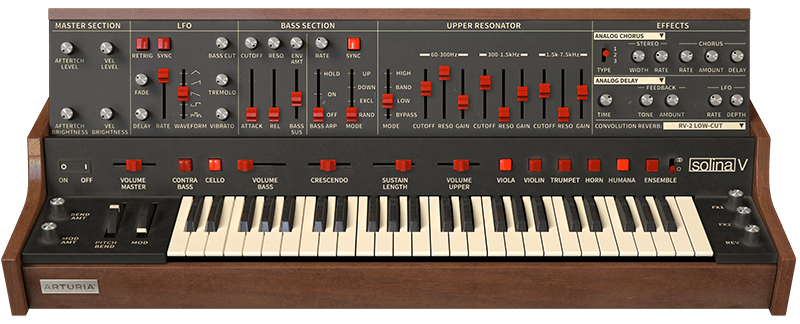
Phasers, echos and reverbs, OH MY!
Thanks to Jean Michel Jarre, the Solina sound is probably most thought of with a slow phaze shifter applied. It is a classic sound that is loved by many. On the Solina V we added a very nice Dual Phaser that will get you that sound and many more. We also added a stereo chorus as well as a digital and analog delay. The crown of the responses from a number of vintage spring and digital reverbs. These reverbs give you many options to add space and time your space music string sounds.

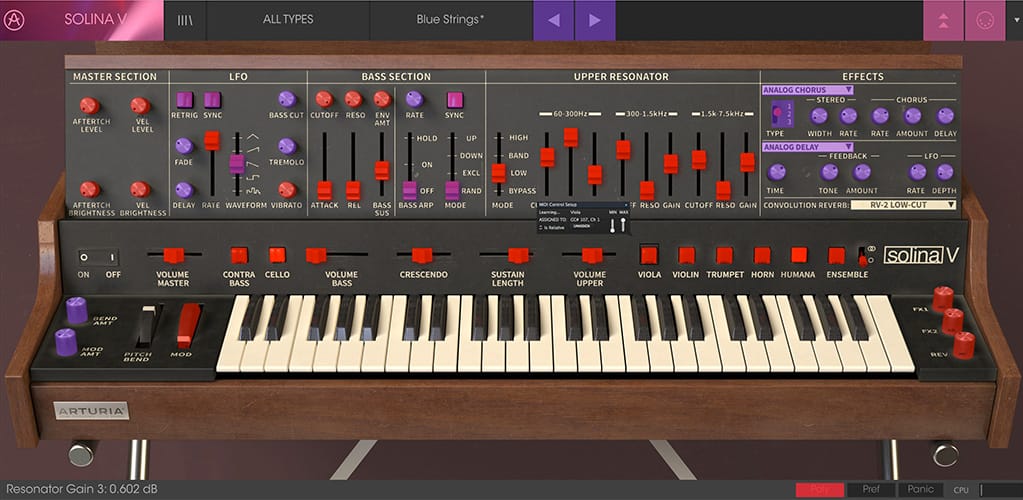
Control Issues?
Don’t let people put you down as having control issues just because you want to be able to remotely access all the parameters of the Solina. You can go right ahead and do just that, and we won’t judge you for it all; in fact we have enabled you by giving you access to ALL the parameters via a simple MIDI learn function. You can also store different configurations and recall them as you please. You can adjust and automate to your hearts content.
Sounds like success
You might initially think that a String machine can only make string sounds. In most cases you would be correct, but with the new features that we have added you get much more than just the best vintage synth strings around. You will find ambient pads, mono leads, basses, brass, arpeggios and more. Whether you are making prog rock, Berlin style, space music, acid lounge, tech hop, stadium rock, Norwegian death metal, vegemite trance shuffle, or any other style of music, you will find excellent sounds that will add to your productions.
Pads
The solina will sound great for long textures, soundscapes.
Strings
The obvious use for the Solina V is the classic string machine sound!
Basses / Leads
Thanks to the extra features and included effects, the Solina V can excel for other types of sounds as well, such as basses or leads.
Pads
The solina will sound great for long textures, soundscapes.
Strings
The obvious use for the Solina V is the classic string machine sound!
Arturia Software Center
The Arturia Software Center (Or ASC) is an application that takes care of your Arturia instruments.
It is the entry point to activate your instruments on a computer. It makes your experience easy and simple.
The Arturia software center lets you download updates, try demos, check details on a specific instrument or purchase.
Included in the V Collection 4

This product is part of the V Collection bundle. This plugin suite puts the sounds of the most legendary synthesizers, electric keyboards, organs, string machines and drum kits, at your finger tips.
The V Collection completes what is missing in your DAW by giving you an arsenal of the best-proven instruments in history.
Learn MorePlatform specifications
 : Win 7+ PC: 4 GB RAM; 2 GHz CPU. 2GB free hard disk space
: Win 7+ PC: 4 GB RAM; 2 GHz CPU. 2GB free hard disk space : 10.8+: 4 GB RAM; 2 GHz CPU. 2GB free hard disk space
: 10.8+: 4 GB RAM; 2 GHz CPU. 2GB free hard disk spaceRequired configuration
Works in Standalone, VST 2.4, VST 3, AAX (ProTools 11), Audio Unit.




Protection
The software is protected by the Arturia Software Center. You can learn more about it here.
Main Features
Vox Humana sound modeled after the original Polymoog™ synthesizer
Classic Paraphonic operation as well as separate Polyphonic mode
Polymoog™ resonator section on Upper Section
24dB per octave resonant filter on Bass Section
Arpeggiator on Bass Section
LFO for Vibrato, Tremolo and filter modulations
Aftertouch and velocity modulations
Solina MK1 and MK2 ensemble modes
3 mode Stereo chorus
stereo dual phaser
analog delay
digital sync delay
Convolution reverb with 24 modeled reverbs
150 presets
What is TAE® ?
TAE® is "True Analog Emulation" - Arturia's exclusive technology which accurately reproduces, tone, waveshape, tuning and other detailed characteristics of an analog synthesizer.
Better reproduction of analog oscillators
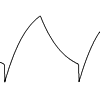
TAE® recreates the characteristics of analog oscillators in amazing detail. The transparency and clarity of our analog synthesizer emulations give the musician a freedom to be inspired by classic sounds or explore new textures with the expectation that previous limitations of digital oscillators will not interrupt the creative flow.
Better reproduction of analog filters
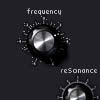
Filters are a major element in substractive sound synthesis. It is important to reproduce the exact characteristics of analog filters in the digital domain, as well as the individual characteristics of classics instruments that give them each their characteristic sound.
Implementation of soft clipping

Soft clipping can give the sound more punch and deeper basses, together with limiting the amplitude of the sound. It is another important point that gives analog synthesis its sound and "attitude".
Oscillators
Better reproduction of analog oscillators
TAE® oscillators are very similar to their analog counterparts for several important reasons.
One of the main reasons is that they are "free", i.e. they are not sampled or wavetable based - or generated from a 0-point when a note is played. Each waveform generated dynamically, allowing the waveform to be in constant adaptation regarding sampling "cutting" and quantization, avoiding one of the major "tell-tale" signs of digital waveform generation and provides a certain level of "liveness" found in the classic analog synthesizers of the past.
Standard digital synthesizers produce aliasing in high frequencies, and also when using Pulse Width Modulation or Frequency Modulation. TAE® allows the production of oscillators that are totally aliasing-free in all contexts (PWM, FM,…), at no extra CPU cost.
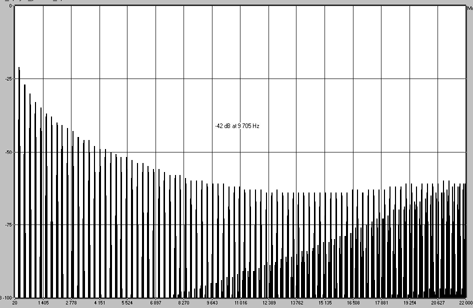
Frequency spectrum of a typical software synthesizer

Frequency spectrum of a TAE® oscillator
Also, all of our oscillators are highly optimized for the particular working frequency. That means that you can play with an instrument exactly as if you played a real analog synthesizer. Again, the waveforms are not presampled and or regenerated with digital perfection, allowing each note to have a life of its own.
In addition, original analog oscillators were unstable. Actually, their wave shape was always slightly different from one period to another. It is also true that due to analog hardware sensitivity, new period trigger times varied with the temperature and other environmental conditions.
TAE® allows the simulation of the oscillator's instability, helping to create warmer and fatter sound.
Original analog oscillators used condensers' unloading to produce common wave shapes (saw tooth, triangle, square). This means that wave forms were slightly curved or distorted in other ways that are considered highly desirable in a musical context. TAE® allows the reproduction of condenser's unload in order to give you the original analog sound.
Because TAE® oscillators are "free" and "alive", when you play a simple chords with raw oscillators, you don't have a digital impression of "fog" or a "blocked" sound, but you have a pleasant feeling of transparency and clarity.
PWM
With TAE®, you can even produce complex PWM sounds with unprecedented quality and, of course, free of any aliasing. It is true for all the our TAE® waveforms (square, triangle, saw…). This produces sounds which are unique on the market, because PWM is very difficult to achieve on certain waveforms like triangle or saw/ramp. We bring you new levels of reality in a virtual analog synthesizer, so that you can achieve new levels of creativity in your music.
Filters
Better Reproduction of Analog with Direct Filter Circuit Modeling
TAE® produces the characteristics of the analog filters in the digital domain.
Let’s take the Prophet V for example. Due to advances in computer processing power, the Prophet V can now employ direct filter modeling techniques to achieve unprecedented accuracy in the emulation of the original's analog 4 pole low pass filter. By modeling the operation of the individual hardware components of the filter circuit, the warm nuances synonymous with the original's analog sounds are recreated.
This graph is a frequency domain plot as just a single example of direct circuit modeling in action; it shows the generation of harmonics at multiples of the resonant frequency when the filter is in self oscillation mode, for both the virtual (blue) and original (red).
These harmonics are characteristic of the Prophet 5's filter and are due to the non-linear behavior inherent in its analog circuitry. The harmonics generated add to the richness and warmth of the sound produced by the filter. As a result of the direct recreation of the analog circuitry in the Prophet V, the same characteristics of the sound are present, thus giving the user a truly analog sound.
Harmonics generated by the filter circuit when in self oscillation prophet 5 original: blue, prophet virtual: red
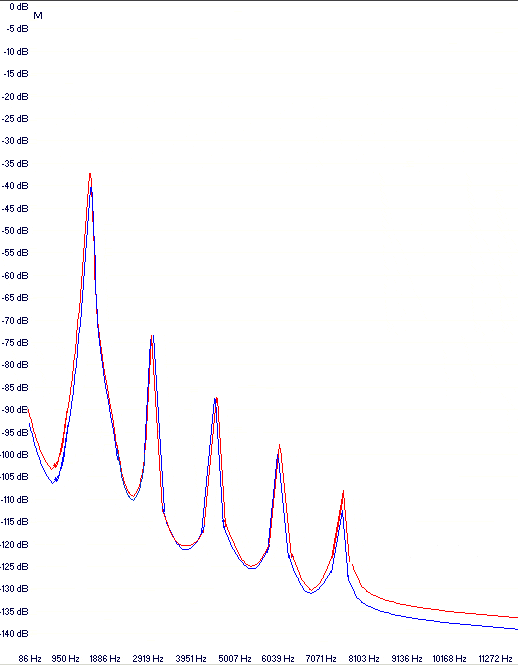
Soft clipping
Implementation of soft clipping
In analog synthesizers, the resonant filter uses a current limiting function, preventing the signal from being too loud (soft clipping).

TAE® allows the reproduction of this current limiting function, making the sound more natural. It also allows filters to enter self-oscillation like original hardware synthesizers do.
Also, soft clipping can be a kind of saturation effect, but with a very particular shape. Common shapes can't give good results compared to analog soft clipping which is very particular to output amplification stages of analog synthetisers, and is a critical component to "the analog sound".
 Artists speak about Solina V
Artists speak about Solina V
For someone who has spent most of their life playing live with real analogue instruments I've always found it so hard to replicate the warmth and fullness with software. Solina bridges that gap so perfectly I imagine my instruments will be gathering dust in my studio now!
Kevin Baird
( Two Doors Cinema Club )
 Artists speak about Solina V
Artists speak about Solina V
The Solina in particular blows my mind. It’s lush and authentic, I’ve used the real thing on numerous records and this is the only emulation that I’d use.
Richard Simpson
( Coldplay )
 Artists speak about Solina V
Artists speak about Solina V
For someone who has spent most of their life playing live with real analogue instruments I've always found it so hard to replicate the warmth and fullness with software. Solina bridges that gap so perfectly I imagine my instruments will be gathering dust in my studio now!
Kevin Baird
( Two Doors Cinema Club )
 Artists speak about Solina V
Artists speak about Solina V
The Solina in particular blows my mind. It’s lush and authentic, I’ve used the real thing on numerous records and this is the only emulation that I’d use.
Richard Simpson
( Coldplay )
This Years Super Model
We began by modeling the original Solina MK1 from Eminent making sure that the Violin, viola, cello, horn and trumpet sounds was as rich and warm as the original. The renowned ENSEMBLE effect was carefully modeled and is a thing of beauty that cannot be found in any of the sample based string machines.

One step beyond
Besides the original features of the Solina that we recreated we took a step further and expanded the sonic pallet beyond anything the original designers could have imagined.
Additions like the Vox Humana and Resonators from the Polymoog synthesizer, original paraphonic and new polyphonic modes of operation, a 24dB per octave filter on the bass section, LFO, Arpeggiator, etc. all add up to creating the biggest and baddest string machine ever.
 Gallery
Gallery
